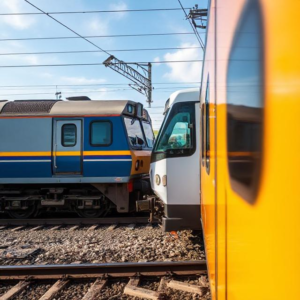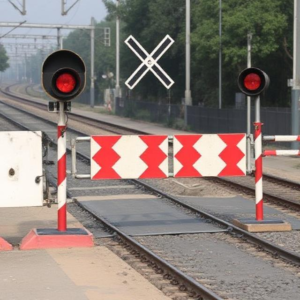Use of Technology to Prevent Train Collisions
Let’s break down how technology is used to prevent train collisions, making the railways safer for everyone. With millions of people traveling by train every day, it’s important to use advanced technology to avoid accidents and keep everything running smoothly.
1. Why Preventing Train Collisions is Important
Trains are large, fast-moving machines, so collisions can be very dangerous. When two trains crash, it can cause serious injuries, delays, and damage. To prevent this, modern technology is used to make sure trains don’t crash into each other. The goal is to increase safety, reduce risks, and improve the efficiency of train travel.

2. How Technology Helps Prevent Train Collisions
There are several types of technology that work together to prevent collisions. Let’s go through some of the most important ones:
a. Positive Train Control (PTC)
One of the most important technologies used to prevent train collisions is Positive Train Control (PTC). Here’s how it works:
- What is PTC? PTC is an advanced system that helps control a train’s speed and movements to prevent accidents. It uses a combination of GPS, radio signals, and computer systems to monitor and control trains.
- How Does PTC Prevent Collisions?
- Automatic Speed Control: PTC can automatically slow down or stop a train if it’s going too fast, if it’s about to enter a dangerous section of track, or if there’s a risk of collision ahead. For example, if a train is heading toward another train on the same track, PTC will apply the brakes to stop it before a crash happens.
- Track Signals: The system continuously monitors signals along the track (like red lights or stop signs) and makes sure the train obeys them. If the driver misses a signal or is about to run a red light, PTC will stop the train automatically.
- Collision Avoidance: PTC can also prevent trains from entering areas where other trains are already moving. It will alert the crew if there’s a risk of a collision and automatically take control if needed.
b. Automatic Train Stop (ATS)
Automatic Train Stop (ATS) is another technology designed to prevent train collisions. It works by using signals and sensors that automatically stop a train if it’s about to pass a signal that indicates danger.
- How Does ATS Work?
- Signal Monitoring: If a train is approaching a signal that indicates stop (like a red light), the ATS system will ensure the train stops before it reaches the danger zone. If the train’s driver doesn’t respond to the signal in time, the ATS will apply the brakes automatically.
- Preventing Over-Speeding: ATS also helps by slowing down or stopping trains that are speeding or going too fast for the conditions.
c. Train Detection Systems
Another key technology is train detection systems, which help keep track of where all the trains are on the tracks at any given time.
- How Does Train Detection Work?
- Track Sensors: Sensors are placed along the railway track to detect the presence of trains. These sensors can measure things like the weight of a train or its speed, allowing the system to know exactly where each train is.
- Monitoring Systems: The data from these sensors is sent to control centers, where operators can track the trains and make sure they don’t end up on the same track at the same time. If two trains are about to meet on a collision course, the system will alert the operators so they can take action to prevent a crash.
d. Collision Avoidance Systems
Collision Avoidance Systems are designed to automatically detect if two trains are on a collision course and take action to stop them.
- How Does Collision Avoidance Work?
- Radar and Cameras: Some collision avoidance systems use radar, lidar, or cameras to scan the tracks ahead and identify potential dangers. For example, if something (like another train or obstacle) is in the way, the system can stop the train automatically.
- Communication Systems: Some systems also allow trains to communicate with each other. If one train detects that there is something blocking the track, it can send an alert to nearby trains, giving them a chance to stop or slow down.
e. Communication-Based Train Control (CBTC)
Communication-Based Train Control (CBTC) is a high-tech system used to control the movements of trains on busy, urban rail networks, like subways.
- How Does CBTC Work?
- Real-Time Communication: CBTC uses wireless communication between trains and control centers to continuously monitor and adjust the speed and position of trains. It ensures that trains are spaced far enough apart to avoid collisions.
- Increased Efficiency: By providing real-time data, CBTC also helps reduce delays and makes train operations smoother. It improves the ability to keep trains running safely and efficiently, especially in busy areas where many trains are running at the same time.
f. Driver Assistance Systems
Some modern trains have driver assistance systems that help the driver stay aware of potential collision risks.
- How Does Driver Assistance Help?
- Alert Systems: These systems alert the driver if they are approaching a signal, station, or curve too fast. They provide warnings to the driver, encouraging them to slow down or take action to prevent an accident.
- Automatic Braking: In some cases, if the driver doesn’t respond to warnings, the system can apply the brakes automatically to prevent a collision.
- Fatigue Detection: Some advanced systems can also monitor the driver’s behavior for signs of fatigue or distraction, providing alerts if the driver is not paying attention.
3. How Do These Technologies Work Together?
In modern railways, multiple technologies work together to prevent collisions. For example:
- PTC might monitor the train’s speed and automatically stop it if it’s going too fast.
- Train detection systems keep track of where all the trains are on the tracks, ensuring that no two trains are on the same track at the same time.
- Driver assistance systems help the train driver avoid mistakes by providing warnings and reminders.
- Communication systems keep all the trains and control centers connected so that everyone knows what’s happening on the tracks in real time.
By combining these technologies, railways can reduce the risk of collisions and improve overall safety.
4. Conclusion
Technology has made train travel safer than ever before. With systems like Positive Train Control (PTC), Automatic Train Stop (ATS), collision avoidance systems, and communication-based train control (CBTC), trains are now better equipped to avoid accidents. These systems help prevent collisions by automatically monitoring and controlling the speed and movement of trains, keeping passengers safe and ensuring trains don’t crash into each other.
These technologies help make sure that the railway system runs smoothly and efficiently, reducing accidents, saving lives, and making travel safer for everyone!
Keywords: Indian Railway, Railway











